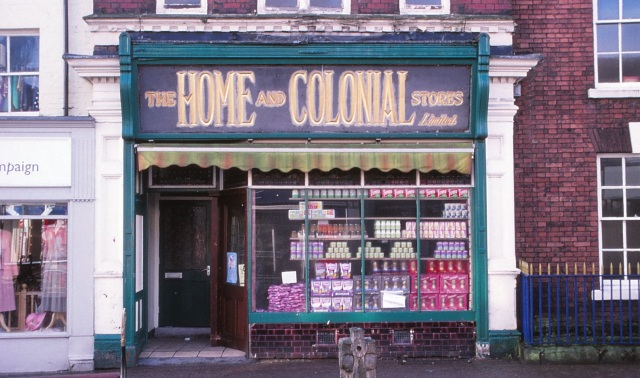
A ‘shopfront within a shopfront’ at 12 Derby Street, Leek, photographed in 2000. The shop is still there, occupied by il Gusto, but the fascia and the ox-blood tiles have been covered up.
Introduction
Decades have passed since large superstores asserted their dominance over the retail food market, yet attractive remnants of old grocery and provision chains can still be spotted on shopping streets throughout the UK. One of the most recognisable is Home & Colonial Stores: a name that evokes the heyday of the British Empire. Particularly characteristic of Home & Colonial shopfronts are transom lights (ie: the fixed glazing above the main display windows and doorways) fitted with coloured and leaded ‘bottle’ glass. In addition, more than one modern shopkeeper has made a feature of Home & Colonial’s distinctive gilded lettering, with its sharp serifs.
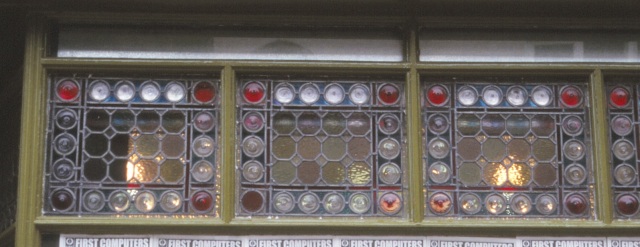
Transom lights at Beulah Street, Harrogate, now ‘abc of health’.
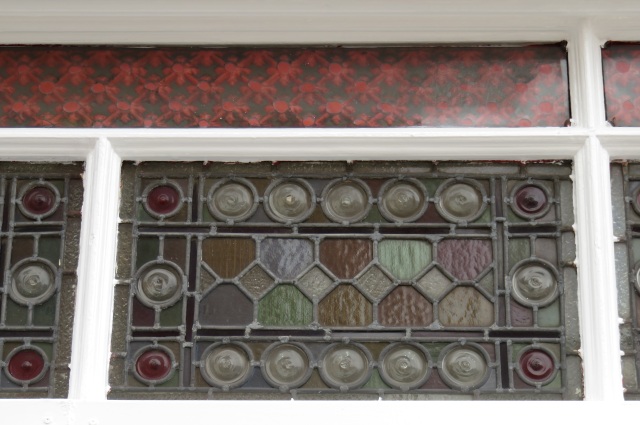
86 High Street, Sheerness. Probably Home & Colonial. Photographed June 2016.
Home & Colonial Stores
The Home & Colonial Trading Association was founded in 1885 by the tea buyer Julius C. Drew (1856-1931) – who later commissioned Sir Edwin Lutyens to design Castle Drogo in Devon – and his business partner, the grocer John Musker (1846-1926), who made his home at Shadwell Park, Norfolk, in 1898. The headquarters and main shop were at 268 Edgware Road, London. Within three years the company comprised four large ‘stores’ – Edgware Road, Islington, Birmingham and Leeds – selling a wide range of groceries and provisions, and nine smaller ‘tea shops’ which concentrated on groceries, especially tea. The ‘tea shops’ set the template for the future.
In order to finance the development of a national chain of ‘stores’ and ‘tea shops’, Home & Colonial Stores was incorporated in March 1888. The company was steered by William Capel Slaughter (of the City solicitors Slaughter & May, married into the Drew family), who served as Chairman until his death in 1917. Expansion was astonishingly rapid. By the end of 1889 there were 53 branches. In the following year new headquarters were taken on Paul Street, Finsbury, London. There were 237 branches (all leasehold) in 1895, 320 in 1897 and 500 in 1903.

‘The Home and Colonial Stores Limited’ in Berkhamsted, now an antiques centre.
As well as tea, coffee and sugar, Home & Colonial shops became popular for their imported butter and margarine. Around 1906 some branches in the north of England were opened as provision (or dairy) shops, with tea being the only ‘grocery’ article on sale, but the general trend was towards diversification of merchandise, including confectionery and tinned goods. Window display was standardised, with branch managers following instructions issued from the head office in London.

Fakenham, Norfolk: the fascia has been covered up since this was taken in 1999. Fabulously, it is the ‘Hot & Cold’ (H&C) Chinese Restaurant.
The general format of Home & Colonial shopfronts was established in 1888. It was probably devised by Robert Willey (1835-1918) who – as Zachary Osborne recently discovered whilst researching Home & Colonial for an academic thesis – was retained as the company’s architect. Willey had a private practice and was also surveyor to the Hand-in-Hand Insurance Co. (later Commercial Union), whose address he shared. The shopfront designed by Willey for Home & Colonial had great longevity, enduring into the mid-20th century. As well as the bottle-glass transom lights and gilded lettering mentioned above, these shopfronts featured brass sills (stall plates) engraved with the legend ‘Home and Colonial Tea Stores’. Beneath this, the stall risers were clad in ox-blood tiles. Windows generally held fixed glazing rather than sashes, befitting Home & Colonial’s emphasis on groceries rather than provisions. To the sides, the pilasters were extremely narrow.
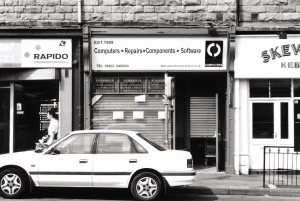
Station Parade, Harrogate, 1999
Further information about Home & Colonial shops of this period is available thanks to legal proceedings initiated in 1898 against the World’s Tea Company, which was accused of deliberately imitating Home & Colonial’s shopfitting and displays: ‘The fascia in each case was much the same in appearance, although, of course, each company put in its own name. Below this in each case a portion of the window was in cathedral glass or lead-lights’. Inside the counters were in similar positions: ‘In each case a [gas] pipe ran over the counter and carried lamps with glasses of a similar shape. In each case, also, there were labels on the walls with the statement “This is the – (cheese, or as the case might be) department”.’ The defendant agreed to make specific alterations to its shops, including, apparently, an undertaking not to lay black and white chequered tile floors.
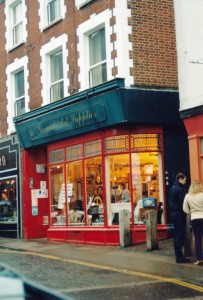
St Benedicts Street, Norwich.
Between the two world wars, Home & Colonial Stores expanded by purchasing three of its main competitors – the struggling Maypole Dairy Co. in 1924, the more prosperous Meadow Dairy Co. in 1929 and the thriving Lipton’s in 1931. It was already associated with Lipton’s through Allied Suppliers, a buying group formed in 1929. In 1960 the holding company, Home and Colonial Stores Co. Ltd., changed its name to Allied Suppliers Ltd, but the subsidiary retail chains (including Lipton’s and Maypole as well as Home & Colonial) retained their original names. Allied Suppliers was bought out by Sir James Goldsmith’s Cavenham Foods in 1972. Within three years the Home & Colonial shops – which had been depleted in the course of the 1960s – had been sold or rebranded.
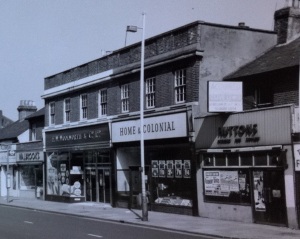
Yiewsley c.1960
Given the passage of over 40 years it is perhaps surprising that so many Home & Colonial shopfronts have survived – albeit in a fragmentary condition. Sadly, no shop interiors exist . . . unless you know otherwise?

The wooden fascia at Leek, minus its glass facing, in 2000.

Pingback: Cake Diary: The Tea Tree – Tea & Happiness
Fascinating. There used to be a H&C Store in Leicester on King Richard’s Road just up from Kate St where I spent my childhood. Just mention of the name evokes the aroma of all the provisions that welcomed customers and my mind can recall it even to this day.
LikeLike
Thanks Tony, I was trying to remember whereabouts the store was in Leicester and you have provided the answer. As a child I could only sat it as Home and Colonical! My Nana shopped there regularly. I too recall the fabulous aromas.
LikeLike
Just going through my grandfather’s (1897 – 1967) mementoes and came across a series of picture flag cards which obviously appeared in every pack of “Perfect Margarine” sold by H & C. Not sure of the date but there is an odd one depicting the first action by the London Scottish 14th Battalion which was in 1914.
LikeLike
I remember shopping as a young boy for my parents(& getting threepence or sixpence for going) in the Home and Colonial Stores in St. Margarets(Twickenham Middlesex)opposite the large Bomb Site,in the late 40’s early 50’s.It had to be before 1952 because both my parents died in 1952 when I was eleven yrs. old I always remember the big square biscuit tins where they weighed your biscuits out from. They also had a tin of broken mixed biscuits that were cheaper to buy than the others.
LikeLike
My great uncle was manager for H&C working as far as I know in Eastbourne and Littlehampton – I have some old photographs which I am happy to share.
LikeLike
Just found this web site about H&C. Would love to see any photos you have. My father was manager of the Canterbury and then Gravesend stores before they closed.
LikeLike
Is there a picture or portrait of the co-founder, John Musker?
LikeLike
I worked at the Home & Colonial store at Tooting Broadway London SW17 in 1968 a very busy shop, 6 on the butchers side, and the provision counter 5 staff, apart from the rest, I work up stairs with someone else, boning and cutting bacon, about 15 sides of ” smoked ” and about 20 sides of ” green ” ( unsmoked ) a week, cheeses, 90 pounders of ” Black Diamond ” Canadian cheddar wrapped in birch bark, Australian cheddar in woodens boxes and New Zealand and all the English cheeses, cooked meats by the crateful, ( Tudor Queen ” was the best quality ) etc, there was a public restaurant upstairs in the front, which was also busy. the staff never had time to stand around chatting, as they do in supermarkets of todays, it was go go go.
LikeLike
My late father Joseph Amphlett was manager of the Wolverhampton branch of the Home and Colonial stores during the second World war and through the 1940’s I cannot be too precise with the dates. I certainly remember visiting the shop as a young child and being sat on the counter. The displays of rows of bacon joints hanging from hooks for the customers to select which side of bacon the wanted theirs sliced from. Sacks of Sugar from which the customers had their required quantity measured out into blue bags and sealed. Most loose goods were displayed in the shop in sacks and measured out to order.
My father was made Area Relief Manager and I believe covered an area of mainly Worcestershire and perhaps Staffordshire, where he travelled to the varies shops covering for the Managers when the took holidays. I would love to see photographs of the Wolverhampton shop and one of the inside of the shops.
LikeLike
I did my Apprenticeship with the Home & Colonial stores .I started on the thirtieth of November 1959
my pay for a 15_16 year old was 95/_d per week .My first shop was in east lane north Wembley i stayed there for about three months and then went to south Kenton shop .The company moved the
Apprentices around for experience .After two years i had completed my Apprenticeship .I do remember the area manager was Mr Stringer
LikeLike
I worked at H&M pontnewydd Cwmbran South Wales July 1970. Worked 4 me& mrs cook . Always sparkle clean and fresh food. It’s was a great pleasure working 4 theme. Always says best job I ever add.
LikeLike
My aunt, Grace Montague, worked at the Edgeware Road H & C for many years, including the war years, until about 1962. She lived quite close by, in an apartment off Bell Street. We were grateful for her abillty to provide extra provisions at Christmastime, as when she arrived for the famiy celebrations she was always well laden.
She worked in a small office out the back in the accounts department with 2 or 3 other ladies. I got to know these ladies and some of the shop staff when I used to visit her on Thursdays (access usually through the back gate off the side street) in my school holidays, and as it was early-closing day she would usually take me to the movies at the nearby, but no longer, cinema
LikeLike
Is there a record of The Home & Colonial property interests in Clifton Street / Worship Street, Shoreditch? They appear to have had a number of warehouses/ factories in the area from the late 1890s until 1930/1940.
LikeLike
Does anyone have any knowledge of the quoted above “Zachary Osborne and his academic thesis researching Home and Colonial”. I would like to get in touch to know more about the history of this store and wondered what angle he was looking at.
LikeLike
Can anyone advise as to the arrival of the H&C stores in Ireland? My father served his apprenticeship in Mountmellick, Co.Laois and later in Bray, Co Wicklow and finally in Dublin. This was roughly between 1938 – 48
Appreciate any help, Liam Egan
LikeLike